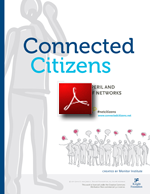
FULL REPORT (PDF):
TIPS AND TRICKS (PDF):
Appendix (PDF):

Ten years ago, a tiny web site asked people to volunteer to write their own encyclopedia. Today, Wikipedia is the most widely used reference work in the world. Rapid advances in digital media and technology are changing how we connect to information and each other. The way we engage in public dialogue, coordinate, solve problems—all of it is shifting. New networks are emerging everywhere. It’s exciting—and frightening. What is this new network-centric world? What does it mean for community change?
These questions matter to us because our work at Knight Foundation hopes to create informed, engaged communities. We see digital technology changing our relationship to news and information from that of passive consumer to active participant. We see new civic attitudes and competencies, with individuals less eager to defer to traditional institutions. As we work at the intersection of media innovation and civic engagement, we see the trends of increasing interdependence, decentralization and transparency. How might our grantmaking respond effectively to a world in which loose networks of individuals, not just formal organizations, are becoming powerful creators of knowledge and action? What default practices should we discard and what new behaviors should we embrace?
We asked our partner, Monitor Institute, to take a critical look at the role of networks in community life. Our lens was apolitical. We were not looking for prescriptions for how citizens and government should interact. Rather, we were interested in the potential of networks—to create stronger bonds or to split us apart. This essay highlights groups that are creatively connecting citizens who are making a difference today, and explores how technology might impact public participation and leadership in the future. The pages are rich with useful examples and lessons about how networks are unlocking assets in communities to support open government, care for the elderly, help disaster victims and advance women’s rights. Throughout, the report considers the role philanthropy can play in harnessing the best network-centric practices, the ones that might unleash individual interactivity to achieve social impact at a scale and speed never before possible.
We have derived much value from this work and hope that it also has meaning for you. We believe there are considerable insights here that will be of interest to those involved in community change—grantmakers, nonprofits, journalists, activists and individuals. Though some of the examples may soon seem quaint, given the rapid pace of change, it’s our hope that the provocative ideas will have staying power—and spark a conversation about how we can strengthen communities by better understanding and strategically supporting networks.

